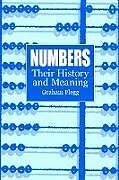Graham Flegg
Klappentext
Much in our daily lives is defined in numerical terms-from the moment we wake in the morning and look at the clock to dialing a phone or paying a bill. But what exactly is a number? When did man begin to count and record numbers? Who made the first calculating machine-and when? At what point did people first think of solving problems by equations? These and many other questions about numbers are answered in this engrossing, clearly written book.
Written for general readers by a teacher of mathematics, the jargon-free text traces the evolution of counting systems, examines important milestones, investigates numbers, words, and symbols used around the world, and identifies common roots. The dawn of numerals is also covered, as are fractions, addition, subtraction, multiplication, division, arithmetic symbols, the origins of infinite cardinal arithmetic, symbols for the unknown, the status of zero, numbers and religious belief, recreational math, algebra, the use of calculators ? from the abacus to the computer ? and a host of other topics.
This entertaining and authoritative book will not only provide general readers with a clearer understanding of numbers and counting systems but will also serve teachers as a useful resource. "The success of Flegg's lively exposition and the care he gives to his surprisingly exciting topic recommend this book to every library." ? Choice.
Inhalt
Preface
Chapter 1. Encountering Numbers
Chapter 2. Counting with Numbers
Rudimentary Beginnings; One-to-One Correspondence and Order; The Beginning of Numbers; Patterns and Groups; Finger-Counting;
Counting by Twos; Counting by Fives; Counting by Twenties; The History of Counting; The Age of our Decimal Counting; Counting with Knots
Chapter 3. Writing down Numbers
Tallies; The Dawn of Numerals; The Development of Numeral Systems; The Evolution of Place-value; Alphabetical Numerals; The Hindu-Arabic Numerals; Fractions; The Derivation of Number-Symbols
Chapter 4. Calculating with Numbers
Addition; Substraction; Multiplication; Division; Checks on Calculation; Ratio and Proportion; Prime Numbers and Factors; The Calculation of Roots; Logarithms; Arithmetic Symbols
Chapter 5. Computing with Numbers
Early Counting Boards; Counting Boards in the Middle Ages; Reckoning on the Lines; The Modern Abacus; The Slide Rule; Calculating Machines; Binary Arithmetic; Computers
Chapter 6. Unknown Numbers
The Linear Unknown; The Square of the Unknown; Higher Powers of the Unknown; More than One Unknown; Indeterminate Unknowns; Symbols for the Unknown
Chapter 7. Recreational Numbers
Think of a Number; Magic Squares; Number Shapes; Numbers with Special Properties
Chapter 8. Thinking about Numbers
Rational and Irrational Numbers; The Real Numbers; The Status of Zero; Complex Numbers; Defining the Natural Numbers; Numbers and Religious Belief
Chapter 9. Teaching and Learning Numbers
Words and Symbols; Elementary Calculation; Algebra; Numbers and Life
Bibliographical Note; Index
